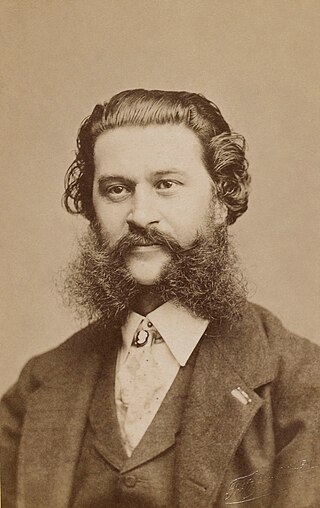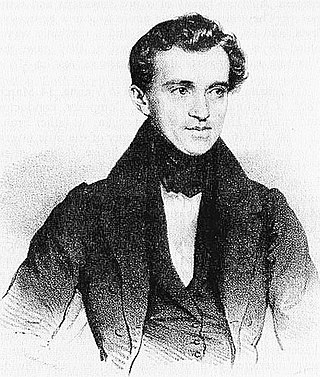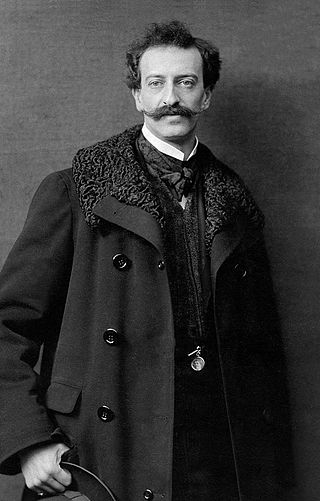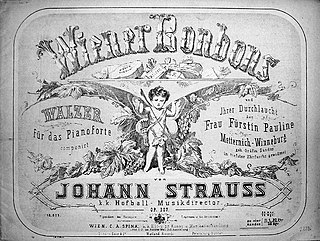Related Research Articles

Johann Baptist Strauss II, also known as Johann Strauss Jr., the Younger or the Son, was an Austrian composer of light music, particularly dance music and operettas as well as a violinist. He composed over 500 waltzes, polkas, quadrilles, and other types of dance music, as well as several operettas and a ballet. In his lifetime, he was known as "The Waltz King", and was largely responsible for the popularity of the waltz in Vienna during the 19th century. Some of Johann Strauss's most famous works include "The Blue Danube", "Kaiser-Walzer", "Tales from the Vienna Woods", "Frühlingsstimmen", and the "Tritsch-Tratsch-Polka". Among his operettas, Die Fledermaus and Der Zigeunerbaron are the best known.

Johann Baptist Strauss I, also known as Johann Strauss Sr., the Elder or the Father, was an Austrian composer of the Romantic Period. He was famous for his light music, namely waltzes, polkas, and galops, which he popularized alongside Joseph Lanner, thereby setting the foundations for his sons—Johann, Josef and Eduard—to carry on his musical dynasty. He is best known for his composition of the Radetzky March.

Oscar Nathan Straus was a Viennese composer of operettas, film scores, and songs. He also wrote about 500 cabaret songs, chamber music, and orchestral and choral works. His original name was actually Strauss, but for professional purposes he deliberately omitted the final 's'. He wished not to be associated with the musical Strauss family of Vienna. However, he did follow the advice of Johann Strauss II in 1898 about abandoning the prospective lure of writing waltzes for the more lucrative business of writing for the theatre.

"The Blue Danube" is the common English title of "An der schönen blauen Donau", Op. 314, a waltz by the Austrian composer Johann Strauss II, composed in 1866. Originally performed on 15 February 1867 at a concert of the Wiener Männergesang-Verein, it has been one of the most consistently popular pieces of music in the classical repertoire. Its initial performance was considered only a mild success, however, and Strauss is reputed to have said, "The devil take the waltz, my only regret is for the coda—I wish that had been a success!"

Wein, Weib und Gesang, Op. 333, is a Viennese waltz by Johann Strauss II. It is a choral waltz in its original form, although it is seldom heard in this version today. It was commissioned for the Vienna Men's Choral Association's so-called Fools' Evening on 2 February 1869 with a dedication to the Association's honorary chorus-master Johann Herbeck. Its fanciful title was drawn from an old adage: "Who loves not wine, women and song remains a fool his whole life long."

Wiener Bonbons, Op. 307, is a waltz by Johann Strauss II written in 1866. It was first performed on 28 January 1866 at the ball of the Association of Industrial Societies held in the ball rooms of the Vienna Hofburg and was dedicated to the influential Princess Pauline Metternich-Winneburg, the wife of then Austrian ambassador to Paris.

Joseph Franz Karl Lanner was an Austrian dance music composer and dance orchestra conductor. He is best remembered as one of the earliest Viennese composers to reform the waltz from a simple peasant dance to something that even the highest society could enjoy, either as an accompaniment to the dance, or for the music's own sake. He was just as famous as his friend and musical rival Johann Strauss I, who was better known outside of Austria in their day because of his concert tours abroad, in particular, to France and England.
Man lebt nur einmal! is a waltz by Johann Strauss II written in 1855. The piece was marked as im Ländlerstyle which in other words means "in the same style as the Ländler", which is an Austrian folk dance. The title was a quotation from Johann Wolfgang von Goethe's 1774 play Clavigo, but it raised a few eyebrows at that time as Vienna was just recovering from a disastrous cholera epidemic and many of the stricken populace may have been superstitious of such a title. Nonetheless, Strauss performed it at the Sperl Ballroom to great acclaim and this waltz has endured lasting appeal even in a simple string arrangement for a quintet consisting of two violins, one viola, one cello, and a double bass.

Rosen aus dem Süden, Op. 388, is a waltz medley composed by Johann Strauss II in 1880 with its themes drawn from the operetta Das Spitzentuch der Königin. Strauss dedicated the waltz to King Umberto I of Italy.
Künstlerleben, Op. 316 is a waltz written by Johann Strauss II in 1867, following closely on the success of the popular "The Blue Danube". Austria was severely shaken the previous year 1866 by the crushing defeat that the Austrian army suffered in the Battle of Königgrätz and many of the year's festivities and balls were cancelled as the prevalent depressing mood affected most of Vienna's populace.
Morgenblätter, Op. 279, is a Viennese waltz composed by Johann Strauss II in 1863 and first performed on 12 January 1864 at the Sofiensaal in Vienna. The work's genesis was attributed to the composition of a waltz by Jacques Offenbach later titled "Abendblätter" when Offenbach dedicated his work to the influential Vienna Authors' and Journalists' Association. The association had earlier intended the "Abendblätter" waltz to be played at their Concordia Ball on 12 January 1864.

Wiener Blut Op. 354 is a waltz by Johann Strauss II first performed by the composer on 22 April 1873. The new dedication waltz was to celebrate the wedding of the Emperor Franz Joseph I's daughter Archduchess Gisela Louise Maria and Prince Leopold of Bavaria. However, the waltz was also chiefly noted by Strauss' biographers as the début of Strauss with the Vienna Philharmonic Orchestra where for many years, the Philharmonic had dismissed any association with the 'Waltz King' as it had not wished to be associated with mere 'light' or 'pops' music. The festival ball celebrating the event was held at the Musikverein Hall which is the venue for the present day Neujahrskonzert.

"Frühlingsstimmen", Op. 410 is an orchestral waltz, with optional solo soprano voice, written in 1882 by Johann Strauss II.
Schatz-Walzer, Op. 418, is a Viennese waltz by Johann Strauss II composed in 1885. The melodies in this waltz were drawn from Strauss' operetta Der Zigeunerbaron, which premiered to critical acclaim on 24 October 1885. Der Zigeunerbaron, a Hungarian-influenced work, remained Strauss' best-remembered operetta after Die Fledermaus. The waltz version was first performed on 22 November that year in the concert hall of the Vienna Musikverein, with Eduard Strauss conducting.
Illustration (Illustrations) op. 331 is a waltz by Johann Strauss II composed in 1869. It was appropriately titled for the annual ball of the Vienna Journalists' and Authors' Association ('Concordia') that was held in the Sofienbad Saal on 26 January the same year.

"Radetzky March", Op. 228, is a march composed by Johann Strauss Sr. and dedicated to Field Marshal Joseph Radetzky von Radetz. First performed on 31 August 1848 in Vienna, it soon became popular among regimented marching soldiers. It has been noted that its tone is more celebratory than martial; Strauss was commissioned to write the piece to commemorate Radetzky's victory at the Battle of Custoza.
Antonín Dvořák's Serenade for Strings in E major, Op. 22 (B. 52), is one of the composer's most popular orchestral works. It was composed in just two weeks in May 1875.
Abschied von St. Petersburg, opus 210, is the name of a waltz composed by Johann Strauss II. The work was first performed at a benefit concert in Pavlovsk on September 5, 1858, as part of a tour of Russia that Strauss was conducting. In keeping with the vogue then current in Russia for the French language, the work was entitled as Mes adieux à St. Pétersbourg. Less than a week after his return to his home city of Vienna, Strauss conducted the first Viennese performance of the work at the Vienna Volksgarten.

Johannes Brahms' Liebeslieder Waltzes (Liebeslieder-Walzer) are distributed across two opus numbers: Op. 52 and Op. 65. The waltzes are a collection of love songs in Ländler style for voices and piano four hands. The lyrics for the Liebeslieder come from Georg Friedrich Daumer's Polydora, a collection of folk songs and love poems. While there is no concrete record indicating the exact inspiration for the Waltzes, there is speculation that Brahms' motivation for the songs was his frustrated love for pianist and composer Clara Schumann.
Dreamwaltzes is an orchestral composition by the American composer Steven Stucky. The work was commissioned by the Minnesota Orchestra for their annual Sommerfest series with support from the Jerome Foundation. The piece was completed in April 1986 and its world premiere was given by the Minnesota Orchestra under the direction of Leonard Slatkin on July 17, 1986. It is dedicated to the violinist Sonya Monosoff and Carl Pancaldo. The piece brought Stucky to prominence in the contemporary classical community and remains one of his most popular compositions.
References
Based on original text by Peter Kemp, The Johann Strauss Society of Great Britain. Used with permission.